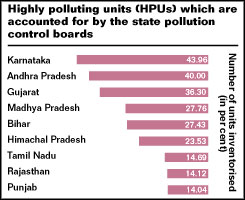Suspended...
 • India generates about five million tonnes of hazarduous waste. But systems to manage it are non-existent
• India generates about five million tonnes of hazarduous waste. But systems to manage it are non-existent
Boards fail to even list the guilty, leave alone penalise
| State | Estimated HWG units | Licensed HWG units (in per cent) | Sites for waste disposal | Sites operational |
| West Bengal | 413 | 15.5 | 5 | 0 |
| Rajasthan | 174 | 63.07 | 5 | 0 |
| Himachal Pradesh | 25 | 76.9 | 1 | 0 |
| Uttar Pradesh | 591 | 71.58 | 3 | 0 |
• Use of effluent treatment plants (ETPs) is a rare phenomenon in India
• In Assam, Himachal Pradesh and Bihar about 50 per cent of the industries with the ETPs do not comply with prescribed standards
Who sleeps on these pollution control boards?
| State | Total number of members | Members whose qualifications are known | Civil servants | Other non- technical members | Technical members |
| Sikkim | 14 | 13 | 8 | 5 | 0 |
| Tamil Nadu | 10 | 10 | 7 | 0 | 3 |
| Maharashtra | 13 | 10 | 6 | 2 | 2 |
| Andhra Pradesh | 15 | 15 | 9 | 4 | 2 |
| Himachal Pradesh | 8 | 8 | 8 | 0 | 0 |
| Andhra Pradesh | 15 | 15 | 9 | 4 | 2 |
| State | As per cent of total expenditure |
| Bihar | 0.084 |
| Goa | 0 |
| Karnataka | 0 |
| Maharashtra | 0 |
| Madhya Pradesh | 0.14 |
| Rajasthan | 0 |
• The Sikkim board, which is without a chairperson, has 14 members. Eight of these are from bureaucracy, four are panchayat members and one is a retired teacher
| State | Polluting units | Technical staff | Percentage |
| Andhra Pradesh | 7,521 | 88 | 1.17 |
| Goa | 248 | 4 | 1.61 |
| West Bengal | 3,414 | 85 | 2.49 |
| Bihar | 1,663 | 171 | 10.28 |
| Uttar Pradesh | 6,441 | 199 | 3.09 |
| Maharashtra | 9,035 | 292 | 3.23 |
• Neither the technical staff in the boards nor the training they are imparted has any correlation with the size or spread of polluting units in the states
Source: Anon 2001, ‘Report on State Pollution Control Boards’, Planning Commission of India, Government of India, Chapter 3,4,5
Related Content
- At a breaking point: The impact of foreign aid cuts on women's organizations in humanitarian crises worldwide
- Report filed by the Andhra Pradesh Pollution Control Board regarding the status of pollution control measures of Narla Tatarao Thermal Power Station, Ibrahimpatnam, NTR district, Andhra Pradesh, 22/02/2025
- Order of the High Court of Uttarakhand regarding mining operations in Bageshwar district, Uttarakhand, 06/01/2025
- Order of the Supreme Court regarding air pollution in Delhi, 02/12/2024
- Order of the National Green Tribunal regarding illegal mining and deforestation among others responsible for the natural calamities in Himachal Pradesh, 29/02/2024
- Report on the holding of night market beside Jal Mahal lake a part of Nahargarh Wildlife Sanctuary and Eco-Sensitive Zone, Jaipur, Rajasthan, 19/08/2023
